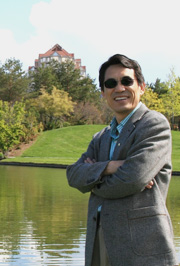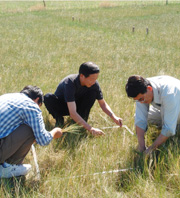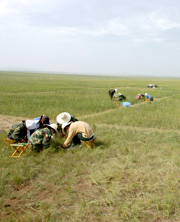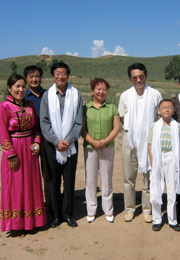September 30, 2011
Q&A with Jianguo Wu

Dr. Jianguo Wu

Ecologists from ASU and the Chinese Academy of Sciences sample plant diversity in Inner Mongolia.

International graduate students and researchers participate in the world’s largest grassland field experiment.

Researchers are greeted by local dignitaries in Inner Mongolia.
Jianguo Wu is a Senior Sustainability Scientist in the Global Institute of Sustainability, a professor in the School of Sustainability, and a Dean’s Distinguished Professor of Landscape Ecology and Sustainability Science in the School of Life Sciences, College of Liberal Arts and Sciences. He is known internationally for his research and teaching in the fields of landscape and urban ecology and as editor-in-chief of the interdisciplinary journal, Landscape Ecology. Wu has been honored with the 2011 Outstanding Scientific Achievements Award from the International Association for Landscape Ecology, the 2010 Distinguished Landscape Ecologist Award from the U.S. Association for Landscape Ecology, and the 2006 Award for International Scientific Cooperation from the American Association for the Advancement of Science.
What focused your research on sustainability?
As an ecologist by training, I have been concerned with the sustainability of local and world ecosystems since my college years. A more comprehensive understanding of sustainability – as a term that encompasses environmental, economic, and social dimensions – began to take shape in my mind after reading the 1999 National Research Council’s report, “Our Common Journey: A Transition Toward Sustainability,” and the seminal paper, “Sustainability Science,” published in 2001 in the journal, Science. My involvement with ASU’s sustainability-related initiatives since 2003 and with the journal, Landscape Ecology, since 2005 have helped me focus my research and teaching increasingly on sustainability-related topics.
What are your most important research projects?
My research group is currently conducting two lines of sustainability-related research. First, we have been working in the Inner Mongolia grassland, addressing research questions ranging from biodiversity to ecosystem services and sustainability. As part of this effort, we have established the world’s largest grassland field experiment to test functioning relationships between biodiversity and the ecosystem. Our ultimate goal is to understand the dynamics of the human-environment relationship on the Mongolian Plateau and seek solutions for sustainable development. Our fundamental question for this work: Is this the end of nomadism on the land of Genghis Khan?
Second, we are studying the ecology and sustainability of urban areas, particularly focusing on several cities in China and the Phoenix metropolitan region. This work quantifies the spatial and temporal patterns of urbanization, identifies its underlying drivers, and evaluates its environmental impacts. A major goal here is to integrate urban ecology and landscape ecology so as to produce “actionable knowledge” for urban sustainability.
How can your sustainability-related research affect future policy decisions?
As urbanization continues, our ecosystems and landscapes will be increasingly “domesticated” or “artificialized,” and our future will increasingly depend on our ability to protect and design nature. Our work in Inner Mongolia has attracted the attention of regional decision makers searching for sustainable development strategies. Our findings on urban ecology will inform policies to promote urban sustainability.
What world sustainability challenges concern you most?
Land use and land cover change is the most important cause of biodiversity loss and ecosystem degradation worldwide, especially when it comes through urbanization. Climate change also poses a serious sustainability challenge. A top priority for sustainability research and practice should be to integrate science and policies so we create resilient landscapes that can adapt to disturbances and climate change.
September 30, 2011

